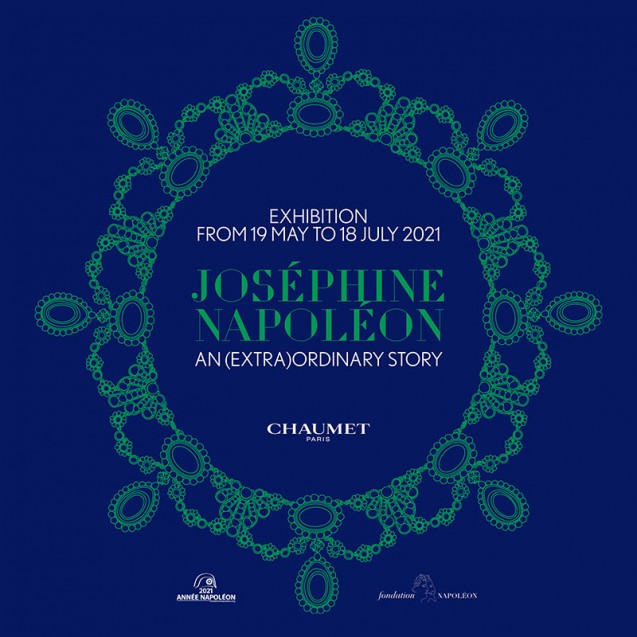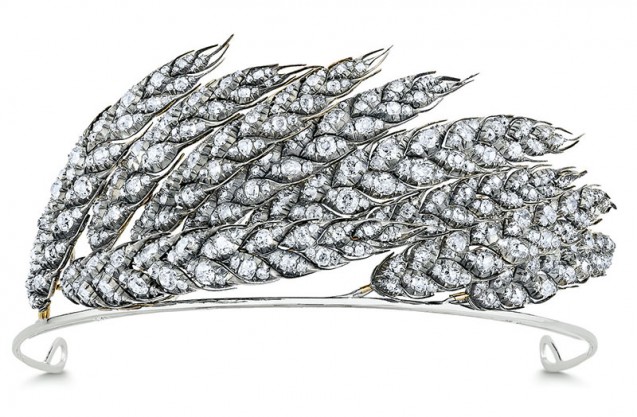A jewellery manifesto
This jewel is composed of 9 ears of wheat set with more than 66 carats of old-cut diamonds set in gold and silver. The item was acquired in 2011, and it is one of the oldest pieces of jewellery in the Chaumet collection. Its status as a “manifesto” derives from several features: first, it perfectly illustrates the art of the tiara, a Chaumet speciality since the 1st Empire; second, its sense of movement and lightness are also characteristic of Chaumet’s virtuosity and its speciality, namely, the ‘art of the line’. With this tiara, it is as if the jeweller had seized the fleeting moment an armful wheat ears tossed by the wind and brought it to life.
The ears of wheat and the Empress Josephine
Ears of wheat, an emblem of prosperity and generosity, evoking rebirth and peace, were among the symbols taken up by Napoleon. As official imperial jeweller, the Maison Nitot regularly used this motif in its creations, notably for Empress Josephine, who liked to wear it as a diadem. Indeed, it was crowned with an ears-of-wheat tiara studded with diamonds that Josephine chose to appear at her first official ceremony as sovereign: the distribution of the crosses of the Legion of Honour at the Invalides church in Paris on 15 July 1804. Madame de Rémusat, in her Memoirs, noted: “She appeared in broad day-light, attired in a robe of rose-colored tulle, spangled with silver stars, and cut very low, according to the fashion of the day. Her headdress consisted of a great number of diamond wheat-ears. This brilliant attire, the elegance of her bearing, the charm of her smile, the sweetness of her countenance produced such an effect that I heard many persons who were present at the ceremony say that the Empress outshone all the ladies of her suite.”
Nitot, official jeweller to Josephine
Though Nitot’s talent had already been recognised by Napoleon – Nitot was asked to set the coronation -, the jeweller won the Empress’ favour in May 1805. On his way to the Vatican in Rome, where he was to deliver the tiara offered by Napoleon to Pope Pius VII to thank the latter for having celebrated the coronation ceremony, François-Regnault Nitot, son of the founder of the House of Chaumet, stopped off in Milan. The Emperor (accompanied by the Empress) was about to be crowned King of Italy, and Talleyrand in fact had asked the Parisian jeweller to present them with a sumptuous gift. Josephine was delighted and impressed, Napoleon congratulated Nitot. Nitot’s destiny then changed: “From that moment on, Monsieur Nitot was admitted to the Empress as her jeweller: later, he obtained the patent [Jeweller to the Empress] and accompanied her on several trips”, noted Mademoiselle Avrillon, Joséphine’s ‘First Chambermaid’. From then on, the orders piled up, and Josephine was to appear in public adorned with sumptuous jewels, the embodiment of the glory of the Empire. Her tiaras, masterpieces and an integral part of her allure, attracted all eyes.
Maison Chaumet, May 2021 (ed./trans. PH)
 This tiara is one of the most exceptional pieces of jewellery to be presented in the exhibition “Joséphine et Napoléon, une histoire (extra)ordinaire” (18 May to 18 July 2021 in the historic salons of the Chaumet Jewellery House, Place Vendôme, Paris, partner of the label “2021 Année Napoléon”.
This tiara is one of the most exceptional pieces of jewellery to be presented in the exhibition “Joséphine et Napoléon, une histoire (extra)ordinaire” (18 May to 18 July 2021 in the historic salons of the Chaumet Jewellery House, Place Vendôme, Paris, partner of the label “2021 Année Napoléon”.


